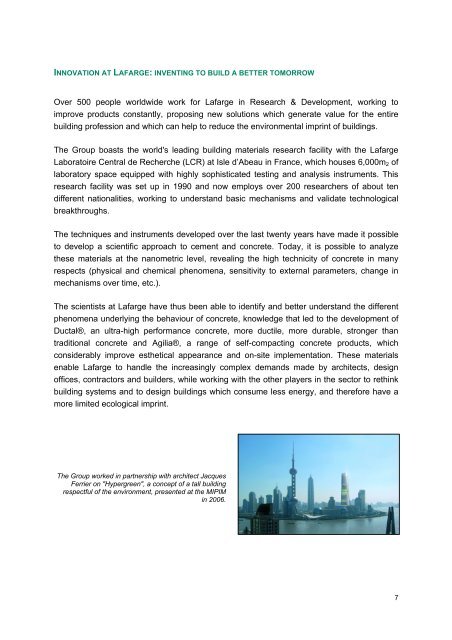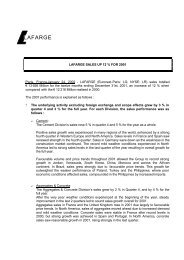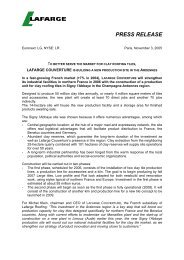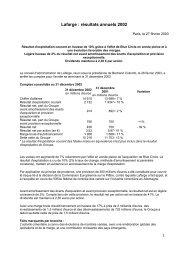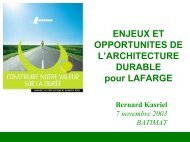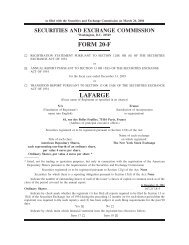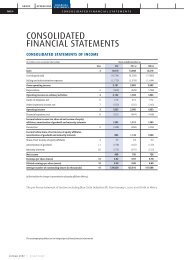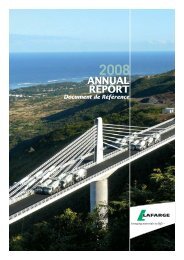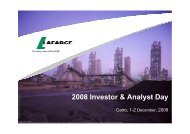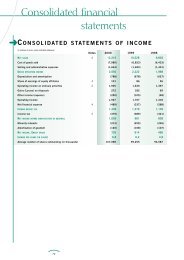A world first for the Villa Navarra by Rudy Ricciotti - Lafarge
A world first for the Villa Navarra by Rudy Ricciotti - Lafarge
A world first for the Villa Navarra by Rudy Ricciotti - Lafarge
You also want an ePaper? Increase the reach of your titles
YUMPU automatically turns print PDFs into web optimized ePapers that Google loves.
INNOVATION AT LAFARGE: INVENTING TO BUILD A BETTER TOMORROW<br />
Over 500 people <strong>world</strong>wide work <strong>for</strong> <strong>Lafarge</strong> in Research & Development, working to<br />
improve products constantly, proposing new solutions which generate value <strong>for</strong> <strong>the</strong> entire<br />
building profession and which can help to reduce <strong>the</strong> environmental imprint of buildings.<br />
The Group boasts <strong>the</strong> <strong>world</strong>'s leading building materials research facility with <strong>the</strong> <strong>Lafarge</strong><br />
Laboratoire Central de Recherche (LCR) at Isle d’Abeau in France, which houses 6,000m2 of<br />
laboratory space equipped with highly sophisticated testing and analysis instruments. This<br />
research facility was set up in 1990 and now employs over 200 researchers of about ten<br />
different nationalities, working to understand basic mechanisms and validate technological<br />
breakthroughs.<br />
The techniques and instruments developed over <strong>the</strong> last twenty years have made it possible<br />
to develop a scientific approach to cement and concrete. Today, it is possible to analyze<br />
<strong>the</strong>se materials at <strong>the</strong> nanometric level, revealing <strong>the</strong> high technicity of concrete in many<br />
respects (physical and chemical phenomena, sensitivity to external parameters, change in<br />
mechanisms over time, etc.).<br />
The scientists at <strong>Lafarge</strong> have thus been able to identify and better understand <strong>the</strong> different<br />
phenomena underlying <strong>the</strong> behaviour of concrete, knowledge that led to <strong>the</strong> development of<br />
Ductal®, an ultra-high per<strong>for</strong>mance concrete, more ductile, more durable, stronger than<br />
traditional concrete and Agilia®, a range of self-compacting concrete products, which<br />
considerably improve es<strong>the</strong>tical appearance and on-site implementation. These materials<br />
enable <strong>Lafarge</strong> to handle <strong>the</strong> increasingly complex demands made <strong>by</strong> architects, design<br />
offices, contractors and builders, while working with <strong>the</strong> o<strong>the</strong>r players in <strong>the</strong> sector to rethink<br />
building systems and to design buildings which consume less energy, and <strong>the</strong>re<strong>for</strong>e have a<br />
more limited ecological imprint.<br />
The Group worked in partnership with architect Jacques<br />
Ferrier on "Hypergreen", a concept of a tall building<br />
respectful of <strong>the</strong> environment, presented at <strong>the</strong> MIPIM<br />
in 2006.<br />
7


